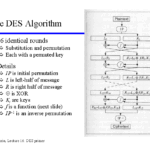In an era where digital interactions permeate every facet of our existence, the security of our online activities becomes paramount. Have you ever paused to consider how that seemingly innocuous email or online transaction is safeguarded against prying eyes? This is where encryption, the digital lock and key of the modern age, plays a pivotal role. Encryption is not merely a technical mechanism; it embodies the very essence of trust in our interconnected world.
Encryption can be likened to a cipher locked away in a vault, accessible only to those who possess the corresponding key. To elucidate this concept, let’s embark on a journey through the intricate landscape of encryption, exploring its mechanisms, applications, and the challenges it presents.
I. Understanding Encryption
At its core, encryption is the process of converting information or data into a code to prevent unauthorized access. The transformation involves algorithms that scramble the original data, rendering it unreadable to anyone without the proper decryption key. This duality of visibility and invisibility enhances the security framework, creating a robust barrier against potential breaches.
There are two predominant forms of encryption: symmetric encryption and asymmetric encryption. In symmetric encryption, the same key is utilized for both encryption and decryption, necessitating the challenge of key distribution without interception. In contrast, asymmetric encryption employs a pair of keys—one public, one private. The public key can be freely shared, while the private key remains confidential, thereby minimizing the risk during the transmission process.
II. The Integral Role of Encryption in Everyday Life
Despite the numerical complexity lurking behind encryption algorithms, its relevance is astonishingly clear in our daily lives. When you send a text message via a secure app or make an online purchase, encryption works silently in the background to safeguard your data from malevolent actors. For instance, technologies such as HTTPS (Hypertext Transfer Protocol Secure) employ encryption to ensure that all communication between your browser and the server is protected. But, what does this really mean for the average user?
Visualize it this way: when you engage in an online transaction, every detail—from your credit card number to your address—is encapsulated with a digital lock. The encryption transforms your information into an undecodable format during transit, effectively ensuring that only the intended recipient can access and comprehend it. This act of digital safeguarding fosters trust, thus allowing commerce and communication to flourish in an otherwise treacherous online landscape.
III. The Spectrum of Encryption in Various Sectors
The significance of encryption transcends personal use; it reverberates across multiple sectors. Financial institutions, healthcare organizations, and governmental bodies all rely heavily on encryption. In the financial realm, protecting sensitive information from fraudsters is paramount. A security breach can compromise personal data, resulting in financial losses and legal ramifications.
In healthcare, patient confidentiality is enshrined in laws such as HIPAA (Health Insurance Portability and Accountability Act). Here, encryption ensures that sensitive health information remains confidential and secure during electronic transmissions. Governmental institutions deploy encryption to secure classified communications, mitigating risks that arise from espionage or cyber warfare. The multifaceted applications of encryption illustrate its foundational role in contemporary security protocols.
IV. The Perpetual Tug-of-War: Security vs. Accessibility
While encryption undoubtedly amplifies security, it introduces a salient paradox: the eternal tug-of-war between security and accessibility. For organizations, high levels of encryption may pose operational challenges. The more robust the encryption, the more complex the access protocols become. This raises a crucial question—how can businesses maintain user-friendly access while ensuring their digital fortresses remain impregnable?
This dilemma is particularly relevant in cloud computing, where heavy encryption can complicate data retrieval processes. Companies must navigate the precarious waters of deploying effective security measures while promoting efficiency. Striking this balance requires innovative thinking and continual adaptation to emerging technologies.
V. Challenges and Risks of Encryption
The world of encryption is not entirely devoid of challenges. Experts often articulate concerns over key management. As previously mentioned, the security of the encryption process hinges on the protection of encryption keys. A compromised key undermines the entire security architecture. Additionally, encryption technology itself is susceptible to evolving threats. Quantum computing, for instance, poses a potential risk to current encryption algorithms, prompting cryptographers to conceptualize advanced techniques such as post-quantum cryptography.
Furthermore, there exists the ethical conundrum of encryption in the landscape of law enforcement. The debate surrounding “backdoors” or methods that allow governmental access to encrypted information potentially imperils user privacy. Navigating these ethical considerations becomes a challenging endeavor, emphasizing the need for a well-rounded discourse on the implications of encryption.
VI. The Future of Encryption
As the digital landscape continues to evolve at a breakneck pace, so too must encryption. The future may behold the integration of artificial intelligence in encryption methodologies. AI could facilitate intelligent algorithms that adapt to new threats in real-time, ensuring a dynamic and responsive approach to cybersecurity.
Moreover, the integration of blockchain technology offers intriguing possibilities for enhancing encryption frameworks. The decentralized nature of blockchain could pave the way for improved security and transparency across numerous applications, thereby transforming how we view encryption in the digital realm.
Conclusion
The digital lock and key metaphors aptly illustrate how encryption serves as a guardian in the tumultuous waters of the digital world. As society grapples with the nuances of cybersecurity, the significance of encryption becomes increasingly apparent. From everyday transactions to national security, its implications ripple through every aspect of modern life. Navigating the labyrinth of encryption presents challenges; however, the exploration of this domain offers a glimpse into the future of secure communication. Ultimately, fostering an understanding of encryption empowers individuals and institutions alike to safeguard both their interests and their privacy in a complex, interconnected world.









Leave a Comment